Birth of a Nation
This is a powerful video.
Birth of a Nation
This is a powerful video.
On Monday, December 7, 2015, Bill Bramhall, editorial cartoonist for the New York Daily News published the following image of presidential candidate Donald J. Trump, in response to Trump’s announced policy of denying Muslim immigration to the U.S.
The image was placed on the cover of the daily paper, overlaid by an updated and paraphrased version of Martin Niemöller’s iconic and poignant quote from 1963 about his inaction regarding Adolf Hitler:

The image shows the Statue of Liberty as a victim of Trump’s political terrorism. Lady Liberty, the beloved symbol of American values and immigration, is beheaded. A bloated Trump raises his weapon of choice, a scimitar, historically associated with Eastern and Ottoman cultures. In effect, Trump balances his own scales of justice with her head in his other hand. The remainder of her majestic body lies prostrate, her torch has tumbled away — her welcoming beacon of light is extinguished.
Bramhall’s image brings to mind Thomas Nast’s 1871 double-paged cartoon,”The Tammany Tiger on the Loose – “What are you going to do about it?””

Though not a cover, (many of Nast’s cartoons were featured as covers), this cartoon received an equally coveted double-page spread in the center of Harper’s Weekly, the premier illustrated weekly of its era. A portly Tweed, whom Nast dresses as a Roman emperor, sits in his imperial reviewing box and gloats upon his weapon of choice, the Tammany Tiger as it takes down Columbia, Nast’s preferred personification of American values. Drawn 15 years before the Statue of Liberty was dedicated in 1886, Nast favored Columbia as the maternal symbol to represent the American nation. Her cousins, Lady Liberty and Lady Justice, distinguished by a crested helmet and the scales of justice respectively, appeared less often as substitutions for Columbia, but frequently as sisterly companions.
Tweed’s tiger looks straight into its audience and bears its teeth, poised to tear into Columbia’s neck. Columbia often carried a sword, symbolizing the strength of her resolve to protect American values of tolerance, fairness, and compassion. Her weapon has left her grip, broken apart by the force of the beast’s pounce. Like Tweed, the tiger arrogantly asks, “What are you going to do about it?”
Thomas Nast, known as the “Father of American Caricature” or alternately as the “Father of the American Political Cartoon” rose to worldwide attention and wielded significant political power by the deft and powerful strokes of his pen — the ire in Nast’s ink often appeared on the cover of the illustrated weekly magazine, Harper’s Weekly. To get his message across, Nast and other great cartoonists of the time employed the ego-cutting tools of caricature: ridicule, physical exaggeration, and careful placement of symbols, to elicit emotions from readers and viewers. Nast is best known for excoriating and bringing down New York politician William M. “Boss” Tweed through these techniques. The visibility and power of Nast images continued for two decades as undeniably effective weapons against corruption.
Few escaped seeing Nast’s images. Apocryphally, Tweed is famously quoted as saying, “Stop them damned pictures. I don’t care so much what the papers say about me. My constituents don’t know how to read, but they can’t help seeing them damned pictures!”
According to Nast’s biographer Alfred Bigelow Paine, Tweed representatives tried to entice Nast with bribes to tempt the artist to stop maligning the city boss. Intrigued, Nast strung the agent along, seeing how high he could negotiate the bribe. It reached $500,000, a tremendous amount of money for its time. Nast refused to be bought.
 This The New Yorker cover from 2008 elicited a great deal of conversation and controversy.
This The New Yorker cover from 2008 elicited a great deal of conversation and controversy.The American editorial or political cartoon in the twenty-first century grasps an uncertain future. The genre thrived in Nast’s era, a time in which photographs could not easily be mass reproduced for the print media. In the century that followed, modern political cartoons traditionally found their stage off the front page, yet, placed in a venerated position in the editorial sections of daily and weekly newspapers. The photograph took over on covers. There were exceptions, of course, the New Yorker magazine being the most notable, today giving prominence to the cartoon cover with provoking results.
The tradition of home delivery or buying a paper at a newsstand and enjoying that publication at the kitchen table or office desk— physically leafing the pages and sharing sections among family and friends, assured these editorial cartoons would be seen multiple times over.
With the demise of many print editions of newspapers and magazines, new generations of readers are now able to cherry-pick their news from online offerings. Some fans of the art form fear that these hand-drawn visual commentaries, and appreciation for what Donald Dewey has called The Art of Ill Will, might lose their historic influence, or get lost among the many clickable headlines, losing ground to the altered digital photograph — satire by Photoshop.
Bramhall’s cartoon offers hope that the cartoon caricature is still beloved. It possesses the qualities to pack a powerful punch. Bramhall’s image rose above the fray and was instantly picked up across media outlets and shared prolifically on social media.
The New York Daily News use of Bramhall’s cartoon as its cover, therefore, is in the best tradition of an excellent and scathingly successful takedown of a public figure by an editorial or political cartoon, drawn and delivered, much like Trump’s sword, as a blunt courier of raw truth. In the best New York City media tradition, the cartoon exposes both the disturbing and the ridiculous.
In our saturated and specialized markets, editorial cartoons must compete for broad attention. But when they are timely and deftly drawn, these black and white lines of editorial expression expose stark realities through exaggeration. Ah! To dish out the glorious tool of ridicule, a technique Trump wields with expertise and lately, to great effect.
Like Nast and Bramhall’s cartoons, the crème de la crème of caricature will always rise to the top — viral-worthy, these images and the artists who create them, serve the public good by striking a tender national nerve and provoking us to consider both the obvious and the subtle.
If Nast were around today, he’d be proud, and perhaps, a little envious.
“Those who cannot remember the past are condemned to repeat it.” – George Santayana, “The Life of Reason,” 1905
Donald Trump is not the first presidential candidate to call for the outright exclusion of a group of people, based on ethnicity or religion, from entering the United States as a visitor, or as an immigrant with aspirations for citizenship. That notoriety goes to James G. Blaine, the U.S. Senator from Maine.
In the late nineteenth century, the three-time presidential hopeful sought to make his second attempt in 1880 a shoe-in by pandering to a xenophobic and fearful population of Euro-centric Americans. Blaine sought to abrogate a treaty protecting Chinese immigration. Needing the support of white labor in the west in order to achieve his presidential aspirations, Blaine encouraged their chants of “The Chinese Must Go!” and promised support of their demands.
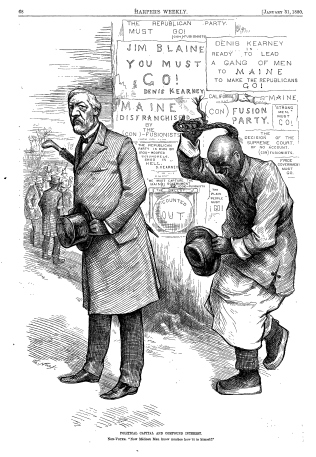
As an 1880 Republican presidential hopeful James G. Blaine called for the official federal exclusion of Chinese entering the U.S. Fear mongering began soon after the Chinese arrived the United States. America offered hope to immigrants from across the globe, including the Far East. Lured to America with tales of gold nuggets, the Chinese were early arrivals during the Gold Rush. Like the Irish flooding into the East coast, the Chinese sought relief from the famine plaguing their homeland.
And while suspicions percolated about the Irish on the East Coast, by the 1870s, Sinophobia reached fever pitch on the other side of America. Blaine took notice. Readying for another attempt at the presidency, Blaine saw political advantage in aligning alongside a new, burgeoning and fearful electorate. In doing so, Blaine broke with his Republican Party’s tolerant position on accepting the Chinese. Nast found Blaine’s defection unforgivable.
In the late nineteenth century, the Chinese in America as a whole, were viewed as a critical threat to the health, welfare, and security of the United States. Derided for their non-Christian (heathen) ways, the Chinese represented a multi-level threat. Popular rhetoric, steeped in propaganda, flourished.
To white workers, citizens and immigrants alike, a life and death line needed to be drawn! Was there any doubt that the rat-eating Chinese would, and had already, spread life-threatening disease and pestilence among innocent Americans? Despite their modest immigration numbers, statistically low compared to other immigrants, the Chinese were nevertheless depicted in commentary and illustrations as invading hordes of less-than-human creatures who would forever alter and undermine a wholesome American national identity and culture.
The pro-business and progressive Republican Party during this era encouraged the Chinese to come to the U.S. Manufacturing and industry, particularly railroad executives, valued the Chinese work ethic and used their eagerness to work as strike breakers. Despite their strangeness, the Chinese were earnest workers and helped tip many businesses balance sheets to the black. This financial reality bolstered the Republican-led, East Coast ruling elite’s tolerant position toward the Chinese. At the very least, having the Chinese in the U.S. made good business sense.
The Democratic Party thought differently. Echoing the fears of its burgeoning white and Irish labor base, Democrats sought to restrict the Chinese from arriving and wanted the ones already in the U.S. to go. Starting on the West Coast with local laws, talk of national laws excluding the Chinese in the U.S. steady gained acceptance during the 1870s. By 1879, the early drafts of the federal Chinese Exclusion Act had been entered into legislation and although vetoed, marked the beginning of the end for Chinese immigration. The writing was on the wall.
Blaine saw where the future votes were. He needed the western vote to win his White House bid. Blaine called for an end to the Burlingame Treaty, a treaty his Republican party had crafted. Blaine renewed the process to officially ban Chinese immigrants – legislation that made life miserable for the Chinese already in the country legally.
Nast obliterated Blaine for his betrayal of Republican values. With a force reminiscent of his treatment toward Tweed, the German-American artist produced a series of devastating cartoons lampooning Blaine and his hypocrisy. A sampling:
8 March 1879 – “The Civilization of Blaine”
15 March 1879 – “A Matter of Taste”
15 March 1879 – “Blaine Language”
22 March 1879 – “Protecting White Labor”
31 March 1880 – “Political Capitol and Compound Interest”
20 March 1880 – “Blaine’s Teas(e)”
1 May 1880 – “Boom! Boom!! Boom!!!”
8 May 1880 – “The “Magnetic” Blaine, or a Very Heavy “Load”-Stone for the Republican Party”
Fully aware of Nast’s role in Tweed’s downfall, Blaine appealed to the artist andHarper’s Weekly General Editor, George W. Curtis, to cease producing the cartoons. Nast’s pen would not be silenced. His cartoons are considered to have played a significant role in Blaine’s unsuccessful presidential bids in 1876, 1880 and 1884. Blaine’s last attempt went as far as earning the Republican nomination.
Blaine’s 1884 campaign, two years after the passage of the Chinese Exclusion Act, propelled both Nast and Curtis to shift their allegiance, a small, but vocal group of progressive-leaning Republicans known as “Mugwumps.” By endorsing the Democratic candidate Grover Cleveland on the pages of the venerated, Republican Harper’s, the move was was startling to the Republican establishment and Party of Lincoln. Although it is widely believed that Nast’s excoriation of Blaine cost the politician the presidency, Nast’s move to the Democratic side, albeit on moral grounds, significantly contributed to the cartoonist’s loss of favor with the Republican base and marked the start of his downward trajectory at Harper’s Weekly. Nast could not remain faithful to his party.
As we all know, Blaine did not become president. Blaine lost his battles, but the war against the Chinese was won. Enacted in 1882, the Chinese Exclusion Act became the first federal legislation to ban outright, a population of people, based solely on ethnicity. Those Chinese already in the United States were prevented from many of the rights extended to other immigrants. They could not vote, were targeted with special taxes, and property rights and ownership were severely restricted. The Chinese in America could not return to their homeland for visits, as their re-entry would be barred, nor could they call for family to join them in the U.S. For the 61 years that the Exclusion Act sat on the books, it effectively and permanently separated Chinese men from their families at home. The Chinese Exclusion Act was repealed in 1943, primarily as a response to the Chinese – American alliance during World War II.
A direct contrast of how the American East and West coast differed toward the Chinese, and other immigrant groups, is shown in two illustrations of an American holiday, both titled Uncle Sam’s Thanksgiving Dinner. These two cartoons demonstrate how a.) influential Harper’s Weekly was as a publication across the entire nation and b.) how differently these regions approached the issue of immigration and communicated their opinions to their audience. (Double-click images to enlarge viewing).
In 1863, Lincoln proclaimed that Thanksgiving would be celebrated on the fourth Thursday in November. However, the Civil War interrupted national observance of the holiday as southern resentment lingered, preventing old Lincoln adversaries from fully accepting the proclamation. Nast’s Thanksgiving illustration was published one year before it became a national holiday in widespread practice.
 Uncle Sam’s Thanksgiving Dinner, 20 November 1869, by Thomas Nast, Harper’s Weekly, Source: Library of Congress
Uncle Sam’s Thanksgiving Dinner, 20 November 1869, by Thomas Nast, Harper’s Weekly, Source: Library of CongressNast’s large woodcut encapsulates the artist’s Radical Republican vision of America after the Civil War. “Nast, Harper’s Weekly and the Republicans they represented did not or could not acknowledge the value of different cognitive, verbal, and social styles, or the sociology behind those differences. They assumed that a universal standard of civility was both natural and necessary” (Hills 118). Nast forms this ideal into an all-inclusive American feast. In the lower corners the sentiments, “Come One Come All,” and “Free and Equal” set the inclusive tone.
At the head of the table is Uncle Sam. He carves a large turkey while an array of nationalities and immigrants politely wait to be served. Universal suffrage and self-governance are featured as the decorative centerpiece. On the back wall, Nast includes his heroes Lincoln and Grant, who flank a center portrait of George Washington, framed by Liberty and Justice. At the table, opposite the host, is Columbia, Nast’s favorite personification of America’s values and promise. Columbia’s kindly face is turned toward her Chinese male guest and his wife and child. It is a very unusual scene since most Chinese in America were men whose families remained in China.
 Rounding out the holiday banquet are representatives of an array of races and religions waiting patiently to begin the feast. The work is more an illustration than an editorial cartoon, the genre from which Nast would later earn international fame with his caricatures of William M. Tweed. Only the Irishman exhibits any hint of mild caricature that could be seen as derogatory. Nast would become highly critical of Irish Americans, but he includes an Irish couple as deserving guests. Nast includes the stereotype to make clear to his audience of Protestant Americans, that Irish Americans had right to be at the table. Nast does not draw the Irishman’s wife in “Bridget” caricature and she is attractive.[1] Babies speckle the drawing. This is a family portrait.
Rounding out the holiday banquet are representatives of an array of races and religions waiting patiently to begin the feast. The work is more an illustration than an editorial cartoon, the genre from which Nast would later earn international fame with his caricatures of William M. Tweed. Only the Irishman exhibits any hint of mild caricature that could be seen as derogatory. Nast would become highly critical of Irish Americans, but he includes an Irish couple as deserving guests. Nast includes the stereotype to make clear to his audience of Protestant Americans, that Irish Americans had right to be at the table. Nast does not draw the Irishman’s wife in “Bridget” caricature and she is attractive.[1] Babies speckle the drawing. This is a family portrait.
The guests represent many races and ethnicities and they dine at the table as equals. Nast does not insert them as mere tokens. He imbues them with respect and dignity. They are people capable of relationships and human emotion. The guests at this American banquet are all different, yet bounded by their common humanity.
Covered dishes everywhere wait to be unveiled. At America’s table, there is enough for all to be served. Behind Uncle Sam is a large painting titled “Welcome” which depicts Castle Garden, the processing center for all immigrants in New York City at the time.
This image represents Nast’s true political, utopian philosophy —his belief in a united America and the potential for the nation’s promise.
In 1877, eight years after Nast’s work, George Frederick Keller produced an identically titled cartoon, undoubtedly a direct spoof of Nast’s holiday illustration. This tattered example (the only apparent extant copy) is seen below:
 Uncle Sam’s Thanksgiving, by G. F. Keller, San Francisco Wasp. Library of Congress, Collection: The Chinese in California 1877
Uncle Sam’s Thanksgiving, by G. F. Keller, San Francisco Wasp. Library of Congress, Collection: The Chinese in California 1877The two artists differed in the power and autonomy their editors extended. By 1869, Nast had become a local celebrity and enjoyed little editorial oversight. Unencumbered by owner/general editor Fletcher Harper (much to the chagrin of Harper’s news editor George Curtis who wanted more artistic control) Nast created his images with free artistic rein.
It is generally accepted among Nast and Harper’s scholars that Nast’s images reflected his personal beliefs rather than a directive from his editors or publishers. Richard West has suggested that The San Francisco Wasp artist G.F. Keller only drew what he was assigned. The fact is, little is known about the artist’s political feelings and there is no indication that Keller had the editorial impunity that Nast enjoyed.
Keller’s image includes several international cultures present at the holiday table. Each male guest at the table is feasting upon his national dish, indicating a refusal to assimilate. There are no wives and children joining them.
 joy Keller’s Chinese man dines on a rat
joy Keller’s Chinese man dines on a ratFront and center, a tweedy Englishman with long sideburns and hand-held spectacles is aghast as he watches a Chinese man dine on a rat.
Columbia, wearing the outfit of a cook, sassily stands at the threshold of the kitchen and dining room. As a foil to Nast’s Columbine embodying American values, Keller faintly draws his maternal symbol. No one is dining on the same food. Hats of many countries dangle from hooks on the wall. A very racialized African American butler preens as he serves Uncle Sam the holiday meal —the turkey. Interestingly, it is not cooked, indicating a lack of civilization and raw hunger. Uncle Sam represents the California view of the ruling Republican government, which clearly prefers the company of barbarians. Keller’s Uncle Sam leans back, utensils at the ready, eager to dig into his bird. The holiday meal and celebratory experiences are not shared at this table.
A throng of nationalities and ethnicities assembles at the dining room’s entry. A man, possibly a Spaniard matador, stretches out his arms to tentatively hold back invading dinner guests which include Eskimos, more Chinese and men wearing unusual headwear representing other cultures. The matador triumphantly raises his montera in the air! The crowd behind him will soon break through. This Thanksgiving Dinner will soon be enveloped in chaos.
Unlike the Nast drawing, where everyone waits until Uncle Sam carves the turkey, here the guests dig into their own individual feasts. No one is waiting for the host to start. They have no manners. They possess no decorum. The message is clear: it is a mistake to include these outsiders at America’s table.
Harper’s enjoyed a national circulation. The San Francisco Wasp catered to the proclivities and prejudices of its local readership. Wasp historian Richard West writes that there is little evidence that The Wasp was distributed east of the Rockies, though a few issues must have been transported by long distance readers. Nast’s comings and goings were documented in California newspapers. As Nast’s popularity and celebrity grew, other artists, including those employed at The Wasp, enjoyed poking fun of Nast in caricature. Eight years after Nast drew his utopian drawing of an all inclusive America, The Wasp responded with its own version.
[1] The prevailing Irish stereotype in New York was of lower-class, monkey-faced simpleton. Nast likely employed the slightly simian look in this work because his audience would not have been able to distinguish the Irish from the English without the stereotype. This was one of Nast’s kinder renditions of the Irish. His animosity toward the Irish would be developed or artistically realized when New York politics saw a larger Irish role.
2. For a very fine account and amazing examples of The Wasp illustrations, I recommend Richard West’s book The San Francisco Wasp An Illustrated History. It is a must have for anyone interested in political art or nineteenth century cartooning and illustrations. West remains the definitive historian on The Wasp and he is often cited in many scholarly works on editorial cartooning, including Nast.
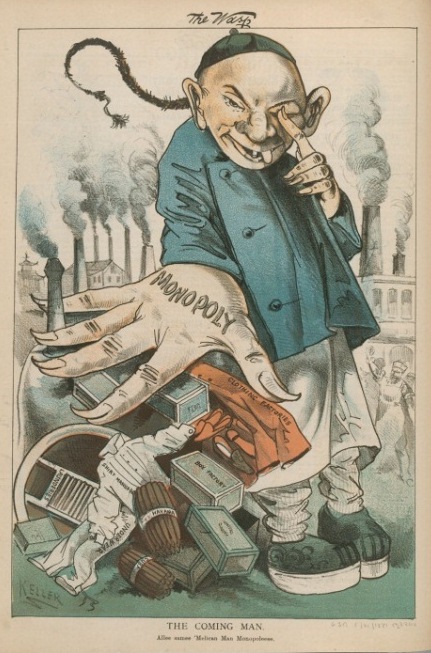
This commanding cartoon was published by The San Francisco Wasp approximately one year before the Chinese Exclusion Act was enacted on May 6, 1882.
The image appealed to white workingmen’s fears of a Chinese takeover of American society and enterprise. Despite the Chinese only occupying 0.002 percent of the population, visual depictions of the Chinese continued to reinforce imagery of infestation and sinister monopolization of industry.
The Coming Man colorfully illustrates the worst in negative stereotyping and Sinophobia. The Chinese man’s over-sized left hand stretches out to the foreground of the image. It is stamped “MONOPOLY” and his fingernails are represented as animal talons, the nails are curled and grow upward like an overhang of a pagoda.
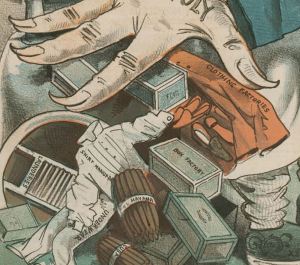
The hand grasps control over trades and services for which the Chinese were most associated – cigar making and sales, laundry, underwear and shirt manufacturing, box factories, clothing, and shoes.
Above his blue mandarin jacket (Chinese tunics were commonly blue, purple or black) is the image of a Chinese nightmare for white Americans. The Chinese man’s face is grotesquely distorted and he greets the viewer head-on with a sinister expression. As if to focus better on those looking upon him, he closes one eye with his index finger to sharpen his stare. His right eye and brow lurch up at an unnatural angle. His ears and nose are large. A devious smile reveals a single tooth, evidence of his bad health. His tongue dangles from the left side of his mouth.
On his shaven head is a skull cap. From the back of his head, the Chinese queue appears to have a life of its own, and whips out from behind the head. The very end of the hair queue looks like the end of a whip.
This Chinese man is not afraid of the white workingman clientele and readers of The Wasp. Behind him and to the left, six factories smolder with industry, possibly a reference to the Chinese Six Companies, an organization which advocated for the Chinese in America. A Chinese pagoda is seen among the buildings. On the right, a few angry, white, Euro-centric workers appear, faintly drawn. They are disappearing. A bearded man wears an apron and a white hat and holds his fist up in the air. Only two factories are viable on this side of the image.
The dominant colors of the cartoon are red, white and blue. This Chinese Man, this “coming man” has taken over the American Dream. He has pushed American workers into the background.
The implicit message of the cartoon is to stoke fear and uncertainty. This man and others like him must be stopped from coming.
The caption reads “Alee samee ‘Melican Man Monopoleeee”

The term “coolie” is commonly associated with Chinese Americans depicted as an involuntary slave labor force, forced cheap labor, or indentured servitude/contract laborers unwittingly recruited and trapped into slave work conditions, or exploited and victimized by low or zero wage compensation. “Coolies” lacked the freedom to leave the work site.
Indeed, many Chinese men were tricked and set aboard ships for paying jobs that did not exist. Many turned out to be slave ships, where men were forced to perform grueling labor in the polluted guano pits of coastal Peru to harvest solidified bird droppings prized as fertilizer. Other Asian slave labor journeyed to the tropics to harvest sugar cane.
Coolie labor differs from an individual offering to undercut one’s rate of pay in order to be competitive – a willingness to negotiate terms of labor. But from the very beginning of the Chinese arrival in the U.S.to work in the gold mines, and sustained through the development of intense anti-Chinese hysteria, the concept of “cheap labor” was synonymous with “coolie labor.” The white workingmen labor movement saw no distinction and all Chinese workers were “coolies” and no different than slaves. “Coolies” undercut all the labor competition. Employers would not hire white men as long as they had a source of “coolies” to do the work instead.
John Kuo Wei Tchen, an authority on Chinese-American history, describes the term “coolie,” and “Chinese labor” as being used interchangeably in the minds of American capitalists during the nineteenth century. The Chinese had arrived in America, specifically on the West Coast, after the 1848 discovery of gold in California, with an aim to strike it rich, and then return to their native China with a significant windfall. These Chinese did not view themselves, nor did Americans view them, as like other immigrants. Instead, they were “sojourners,” individuals who planned to stay in the United States temporarily, just long enough to make enough money to return home and provide economic security for their families back in China. The financial windfall promised from gold mining did not meet expectations and most Chinese remained in America and sought other means to earn money.
Tchen quotes a Protestant missionary in China describes how many viewed the Chinese labor as an export product and opportunity on which to capitalize (169),
The Coolie trade, it will be seen is speculation in human labor. In other words, it is reducing human labor to the list of marketable commodities –making it an object of purchase and sale, and holding it, subject to the various vicissitudes which attend stocks, provisions, dry goods and other articles of commerce.
The year 1870 “marked the moment at which struggles between capital and labor interpenetrated commercial culture, producing a common visual and written language in which Chinese labor would be represented in national political debate” (Tchen 167).
Post-Civil War industrialization created a need for labor. The Burlingame Treaty, enacted in 1868, sought in part to facilitate expansion of trade between the U.S. and China. The United States with the annexation of Alaska and inclusion of California and other western states needed plentiful labor. Treaties with Native Americans were abrogated in order to connect the East and West Coasts with the transatlantic railroad. A larger United States needed and encouraged the spread of homesteading, commerce, and European immigration. “At the same time, “cheap”–and seemingly limitless–Chinese labor became a highly desirable commodity for post-slavery capitalist” (Tchen 168-169).
But it was the lure of gold that beckoned those from China’s port cities to leave behind their rice farms and fishing villages and turn their ambitions toward the “Gold Mountain,” of California. “Facing warlords, destitution, and British battleships,” Chinese villagers were enticed by advertisements describing America as a land of plenty (Pfaelzer 4).
In addition to men tricked to work in slave shops, women were kidnapped and forced to serve as prostitutes for the burgeoning gold mining community. Not surprisingly, these women died early from diseases. The state of their health was used to define all Chinese women as immoral, reason enough to restrict their immigration into America. The cruel conditions these women were forced to endure lent credence to some American claims that the Chinese were unsanitary and carriers of disease.
“Free labor” had been swirling around as a concept, an ideal and a goal as anti-slavery ideology began to grow in antebellum America. “Chinese miners arrived in a new state that had just voted to outlaw slavery” (Pfaelzer 25).
Many Americans, fresh with the memory of battling slavery, could point to “coolies” as an anathema to free will. “From the outset, the penny press widely reported the uses and abuses of Chinese and South Asian indentured “coolie” labor” (Tchen 169) and were disturbed by its reality.
The problem was that the perception of “coolie” labor extended to those Chinese who were in fact, not being forced to work at all. Many had entrepreneurial ambitions and created businesses that fit the need of a growing community or boon town.
“The great majority of Chinese arriving in the United States were not contract laborers” (Tchen 170). By repeatedly classifying all Chinese labor as “coolie labor” and successfully blurring that distinction, the white labor movement, particularly the Workingmen’s Party led by Denis Kearney succeeded in presenting a moral argument to their rallying cry that, “The Chinese Must Go.”
In October 2011, Thomas Nast, (1840-1902) appeared among a list of distinguished individuals nominated again for induction into The New Jersey Hall of Fame. The nomination, Nast’s third in four years, would not result in his induction. Despite Nast’s legacy as the “Father of the American Caricature” (Harper’s Weekly, Dec. 20, 1902), the accolades and fame earned for his series of approximately 50 cartoons exposing the corrupt New York City Tammany Hall boss William Meager Tweed would not be enough. Rather, it would be another Nast legacy, his anti-Irish and anti-Catholic cartoons drawn primarily in the late-1860s to mid-1870s, which determined Nast’s failure to be included in the Hall of Fame roster.
Caricature can be a cruel expression of contempt. Cartoon historians Stephen Hess and Milton Kaplan refer to caricature as the Ungentlemanly Art; Donald Dewey, the Art of Ill Will. As an editorial caricaturist, Nast relied on techniques to exaggerate physical features, employ personal ridicule, symbolism, and stereotype to expose what he saw as “a struggle between good and evil” (Dewey 7). Nast viewed Irish Americans and the Catholic Church in the post-Civil War era as direct threats to the Republican values of inclusion, unity, toleration, and fairness. He saw the rise of Tweed’s Democratic Tammany Hall Ring, the Irish immigrants, and American Roman Catholics as inexorably linked, one group enabling the others’ prominence.
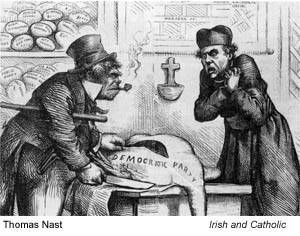
Nearly a century and a half after they were drawn, Nast’s Irish and Catholic depictions continue to deeply offend. Reprising an English tradition of depicting the Irish as beasts, most typically as apes, Nast’s Irish was a brutish, violent- loving, jaw-jutting aggressor.
Nast, who was born and baptized in the Catholic faith, and received early Catholic education, frequently drew sinister-looking Catholic clergy, usually elaborately robed and surrounded by riches. Recently, these images have resurfaced as a retort to Nast’s 2011 Hall of Fame nomination. The cartoons appear in numerous blogs and editorials – examples offered to prove that Thomas Nast was a racist and a bigot. These images should not be viewed in isolation, without historical context to explain their purpose.
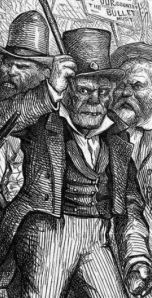
Thomas Nast had a well-established history of supporting fairness and equity, but he would quickly attack those he had previously championed when he perceived hypocrisy, corruption or stupidity within the ranks of previous favorites. Nast’s most famous targets: Tweed and the Irish-Americans Catholics who affiliated with and benefited from the political boss, had questionable alliances and political stances. As emerging actors in New York City Democratic politics, Irish-American Catholics under Tweed’s protection provided a critical backdrop in which a six-year-old Catholic immigrant from Germany came of age, and formed a political identity. Nast witnessed extraordinary characters and cultures, indeed he was part of New York City’s immigrant identity. As Nast matured in this cultural and political soup, he found a passionate solidarity within the progressive politics of the new Republican Party. In particular, after the Civil War, Nast identified his enemies as Democrats and their positions on key social and political issues fueled the ire in his ink.
Nast critics deserve a hearing, however. For example, in his 1863 Emancipation drawing, Nast took great effort to present an optimistic vision of African Americans contrasted against a reminder of African American slavery and oppression. It was important for Nast to present the two together. But when it came to the Irish-American experience, Nast did not explore or comment on the Irish’s long history of oppression in Europe. Nast appears not to have considered any background material which could have furthered his understanding of their collective behavior in America. His work is not sympathetic to the Irish’s dire living conditions in New York City. Nast may have shared a common attitude held by most Germans Americans that they superior to the Irish.
If Nast felt superior, he was not alone. Dale Knobel explains that the rank and file Americans, prior to the war at least, believed that environment was a direct result of a defect in character – in this case, the native Irish character, and character developed from one’s environment. The prevailing view among Protestant Americans held that the Irish had made poor life decisions (marrying early, too many children, following a pope and superstitious religion) and therefore deserved their troubled lot in life (82). Irish-American historian Timothy Meagher writes that Ireland’s troubled history is often overlooked when explaining subsequent Irish American behavior. The Irish didn’t act like Germans because “they were from Ireland and had learned “lessons” there that shaped their reaction” to other races religions and cultures (224).
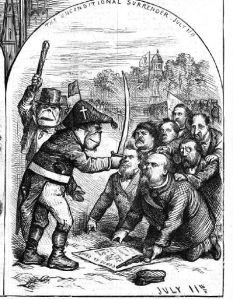
Had Nast fully studied and appreciated the Irish’s history of oppression and the extraordinary circumstances that caused them to emigrate to America, would he have excused the intertwined relationship of Irish Catholics with Tweed? Probably not. As sympathetic as he was to African Americans, Nast later resorted to racial caricatures and lampooned African Americans when they (in Nast’s opinion) too easily gave away new civil rights gains in the early days of the Restoration. Nast felt they hurridly compromised with southern Democratic politicians — a ruling class Nast felt to to be insincere and corrupt.
Blacks, who Nast once drew with dignity and respect, later became guffawing simpletons who didn’t know better — incapable of navigating through the complex and murky waters of southern politics. As tender as Nast could be in an image like Emancipation, he could be unmerciful in his treatment of minorities in images like The Ignorant Vote. These depictions couldn’t be any more inconsistent.
Albert Bigelow Paine, (1861-1937) was Nast’s only contemporary biographer and penned a reverential 600-page tome published two years after Nast’s death. Paine interviewed Nast toward the end of his life, and he does not challenge the recollections of his subject and the anti-Irish and anti-Catholic drawings are weakly examined.
In an effort to explain away the anti-Catholic reputation that had obviously lingered and threatened to tarnish Nast’s legacy, Paine wrote, “He was inspired by no antagonism to any church–indeed he was always attracted by Catholic forms and ceremonies” (150).
Extraordinary and divisive national events shaped Nast’s persona and outlook. In his adopted country, Nast embraced and championed a Republican political view — a position reinforced by his employers at Harper’s Weekly and the at-large intelligentsia of the day. His attitudes about the Irish were not at all unusual. This was the era when “Irish Need Not Apply” signs proliferated across storefronts and businesses. Knobel’s convincing research makes this very clear. In this atmosphere of an evolving America, Nast transitioned from an illustrator to a caricaturist; the latter’s prime purpose was to expose, within his immediate environment, malfeasance, corruption, lapses in morality, etc. To be successful and effective as a visual commentator and observer, his caricature needed to shock and startle. Caricature provokes and elicits conversation and debate.
In using caricature, Nast purposely fired a weapon clearly meant to exaggerate, upset, and call attention to a specific issue or crime. Exaggeration was precisely his point. Nast argued for diversity and illustrated these differences with recognizable symbols his readers would immediately grasp — an artist’s version of shorthand.
How would Nast have drawn a positive image of an Irishman? Perhaps he did, and these white, Euro-centric faces simply blend in. How would we recognize a positive Nast Irishman if he did not use stereotype? Wouldn’t the Irish look like any other Anglo-American? When something was wrong, went wrong,, Nast drew out his pen and pencil and fired off an attack. The Irish and Catholic alliance with Tweed and the growth of their political prominence and activism (including adopting a pro-slavery political position) provided the fodder — the examples for Nast to run with his preconceptions.
In his book the Irish stereotype, Paddy and the Republic, Dale Knobel quotes Harold Lasswell, a content analyst who helped compile period material for the book,
It is impossible to get inside the mind and observe attitude as one might observe conduct. We obtain insight into the world of the other person when we are fully aware of what has come to his attention (qtd. Knobel xv).
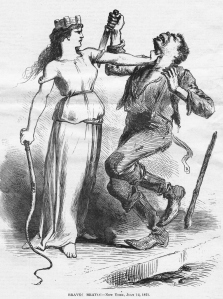 When one browses the Internet and grabs one of Nast’s drawings do we know the full story? Nast drew more than 2,200 cartoons for Harper’s Weekly (Kennedy) alone. A vast majority of his images focused on the people, groups, and religion of my Irish ancestors. In these pieces, I see a slice of history as it was, not how I wish it would have been! His images are historic and possess intrinsic value. Nast came of age during events, controversies, drama, and a cascade of cultures. In order to assess the layers of meaning, and do it with justice, involves an extraordinary commitment of time and affection for history. To fairly evaluate these documents (and Nast’s images) involves having an open mind and a curious nature willing to explore the many backstories and cultures that shaped individual attitudes and behavior during Nast’s career. Every detail — the meaning behind every symbol, the tradition and origin of each stereotype, and the significance of the words, placards, and captions that accompany his caricatures all play a vital role in understanding these cartoons.
When one browses the Internet and grabs one of Nast’s drawings do we know the full story? Nast drew more than 2,200 cartoons for Harper’s Weekly (Kennedy) alone. A vast majority of his images focused on the people, groups, and religion of my Irish ancestors. In these pieces, I see a slice of history as it was, not how I wish it would have been! His images are historic and possess intrinsic value. Nast came of age during events, controversies, drama, and a cascade of cultures. In order to assess the layers of meaning, and do it with justice, involves an extraordinary commitment of time and affection for history. To fairly evaluate these documents (and Nast’s images) involves having an open mind and a curious nature willing to explore the many backstories and cultures that shaped individual attitudes and behavior during Nast’s career. Every detail — the meaning behind every symbol, the tradition and origin of each stereotype, and the significance of the words, placards, and captions that accompany his caricatures all play a vital role in understanding these cartoons.
Caricature and editorial cartoons go beyond mere illustration. Simple illustration captures the obvious action along with the ingredients that everyone recognizes. Caricature captures an unseen truth — a truth exposed, an opinion perhaps, that many would prefer to brush under the carpet. Caricature peels back the layers of illusion and exposes a starker reality.
Had it not been for particular political alliances, which in Nast’s view involved stolen elections, misappropriated public funds, and an enormity of ego and arrogance, there would have been few reasons for Nast to have attacked Irish Catholics. Every line Nast drew, he executed toward achieving or arguing for a Republican political view. One may not agree with Nast’s political thinking, but those who are informed about his life and times find it difficult to question the well of integrity from with which he drew his creative inspiration and the evidence of corruption that swirled all around him compelled him to take action. See Uncle Sam’s Thanksgiving Dinner.
Nast took to task the people he saw as villains, and as a result, in the eyes of many, became one himself. Nast did not glamorize the villains and threats of his day. He obliterated them through the exposure of black lines on white paper. As wrong as these perceptions and images might feel today, the truth is, most people felt that way toward the Irish. Because of his ability to visualize the way ordinary Americans felt, Thomas Nast now bears the brunt and identification of owning this attitude lock, stock, and barrel.
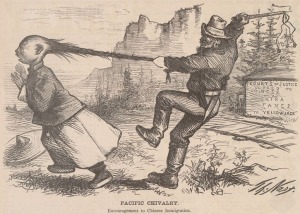
Today, Americans with an Irish heritage often react with anger at Nast’s nomination, and may not fully understand nor be willing to accept the knowledge that a sizable portion of our ancestors, horribly oppressed in Ireland, became oppressors in America. Ignorance is bliss. In the Irish-American struggle to fit into mainstream America, other immigrant groups were mistreated, most notably the Chinese, by the Irish and other white groups. In climbing the rung and elevating one’s status from a low life meant another group had to occupy the lower tier. Horrible things were done to the Chinese in caricature and more importantly, in everyday life. In a large part of organized Irish activism, the Chinese faced a battery of restrictive legislation and were officially excluded from immigrating to America with the Chinese Exclusion Act of 1882.
Historical figures like Nast should not be kept out of museums or halls of fame any more than Mark Twain’s use of the N-word should be erased from modern editions of Huckleberry Finn. Our history is full of unique people who did not all get along. The beginning of the immigration era of American history is complicated, extraordinary and often cruel. Nast deserves to be in New Jersey’s Hall of Fame because he earned a place in history through his exposure of political corruption and for documenting the Civil War, national elections, minority struggles and visually capturing and recording northeastern Republican attitudes of a still young nation seeking to reconcile after the Civil War. His art shaped ideas. Not all of us are going to like what he did, and that is fair, but we can’t pretend it didn’t happen.
Today, Thomas Nast’s controversial images are an important educational tool for explaining how and why images matter, how stereotypes are developed, used or misused. Caricature is not illustration and it is not meant to be viewed as such. It is sarcasm, it is an over-the-top exaggeration. Its very nature is controversial and Nast executed that art form as few others could, and for that reason alone, regardless of content, he deserves a spot in New Jersey’s Hall of Fame.
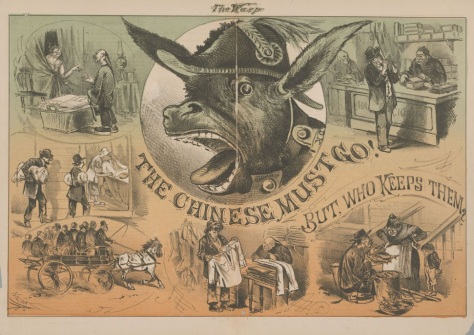
The Chinese Must Go, But Who Keeps Them? was drawn by George F. Keller and published on May 11, 1878. The cartoon is The Wasp’s interpretation of the Workingmen’s Party’s rallying cry against Chinese presence in California. Front and center is a donkey in military garb, an indication of a war- war against the Chinese, and liberal immigration policies. On the epaulets of the donkey’s uniform, the initials “D.K.” represent the faction’s self-styled military leader, Irish-born Denis Kearney and chief crier of “the Chinese Must Go” mantra. Kearney, a charismatic Irish American “began his infamous outdoor “Sandlot” meetings on vacant lots…and understood how to turn rage about unemployment, the price of food, and the huge land grants to the railroads against the Chinese” (Pfaelzer 77).
The cartoon’s title question has a double meaning. Kearney and his Workingmen’s Party were clear on one goal. They wanted the Chinese out of California- out of the West Coast – out of the labor market. Go back to China, go East – as long as they went. They cared little about who would take care of the Chinese afterward.
The title challenges the readers to look within. Who was taking care of the Chinese in California? Who was keeping them, enabling them, to stay in California? The Wasp pointed the finger at their readers.
Surrounding the braying Kearney, six vignettes show the consequences of white citizens patronizing Chinese business; a cigar shop, shoe cobbler, laundry, horse livery and meat butcher. All professions that the Chinese successfully established and sustained through white patronage. White dollars kept the Chinese in place. By asking, “But who keeps them?” the cartoon places the blame directly upon white households. The editorial called for widespread boycotts of Chinese goods and services.
White woman in California were reluctant to give up the freedoms they had enjoyed by subbing out the domestic work to Chinese businesses. “Their freedom to travel east, to visit friends and family, and their time for church and artistic clubs – all the result of inexpensive Chinese servants – was in jeopardy” (Pfaelzer 66).
As the 1873 economic collapse persisted well into 1876, anti-Chinese zealotry organized into groups, such as the Supreme Order of the Caucasians, who vowed to “annihilate” white people who did not follow their “hit list” of boycotts (Pfaelzer 67).
However, the image is not entirely flattering to Irish-born Kearney and his followers. According to Richard Samuel West, The Wasp abhorred mob violence and the paper adopted the editorial position that while it believed in the true threat of Chinese labor at the expense of white labor, Kearney’s method lacked dignity. Unlike Nast who drew Kearney’s realistically, The Wasp rarely used Kearney’s face in their magazines and in this particular instance, preferred to use the Democratic donkey in his place. “The animal appealed to illustrators for its jackass connotations” (Dewey 17).
Nevertheless, Kearney’s Sandlot speeches resonated with California Democrats and the working class who comprised Kearney’s Workingmen’s Party. “Just two years later, the new party managed to rewrite local anti-Chinese codes into the second California constitution” (Pfaelzer 78-79). Other anti-Chinese measures would follow in California, and loomed on the federal horizon. Back east, Thomas Nast took notice as he watched the Democratic Party gain influence over the electorate and contribute to the shifting public policy against the Chinese. To Nast’s horror, Republicans came under the influence, as well.
Nast drew numerous cartoons sympathetic to the Chinese’s plight in America. Many of his cartoons react to unfolding events in California. Nast included many references to Kearney in his cartoons, often sarcastically quoting him on wall posters. See example: Every Dog (No Distinction of Color) Has His Day, February 8, 1879.
It should be noted that Keller’s donkey wears a bicorn military hat. A few of Nast’s anti-Chinese cartoon figures contain a military figure wearing a bicorn hat. This may or may not serve as a symbol for Kearney. In the context of Nast’s cartoons, the suggestion seems plausible.

Clearly fixated on the labor issue the cartoon incorporates two of West’ six themes favored by The Wasp: the Chinese as ruthless competitors and subversive labor monsters.
The frame is divided, two-thirds occupied and dominated by an eleven-handed Chinese worker-monster. “The Chinese were depicted as “many handed” or monstrous creatures depriving white labors of their jobs” (Choy 84). Keller’s uber-octopus like Chinese laborer is seen going to town, a busy industrial whirlwind of labor productivity. He is unstoppable in the trades and crafts most attributed to Chinese workers; shoemaker, tailor, cigar maker and laundryman testifies his industriousness. Collectively, his array of hands holds a saw, mallet, hammer, and brush. Most dangerous of all, he is succeeding. Two hands are busy socking away a substantial bag of money and assures the satchel is carted off in a rickshaw to export “For China.” “Chinese Trade Monopoly” is secured in place with his foot. The image emphasizes the prevailing anti-Chinese view that the Chinese aren’t like other immigrants. They are instead “sojourners” whose only wish is to make money in America to send back to their families in China. The cartoon does not reference the fact that the Chinese were legally restricted from becoming naturalized citizens.
In the event the viewer does not fully appreciate the implications of this Chinese monster, the remaining third of the screen, clean shaven, non-threatening white boys collect with nothing to do, loitering outside. These are not angry Irish boys. They are victims of the Chinese menace. These young men are well dressed, with jackets and hats and bear pensive expressions – chins resting on their hands. One young man leans on a lamppost with an American Eagle on top, and another leans against the side of the one-man Chinese factory. Without a future, they are, as the caption points out “our boys.” A police officer leads one of the loiterers away to one of three structures in the distance. What path lies in the boy’s future? What fate? Institutions in the distance provide the grim answer, “San Quentin,” “Industrial School,” or “House of Correction.” The message is clear. The Chinese labor problem erodes an opportunity for wholesome, American boys to obtain honest work. They cannot compete with the whirlwind of cheap, Chinese labor. Inside, the Chinese phenomenon could care less. Keller imbues him with a gleeful, sinister expression as he monopolizes and spins profits.
The Chinese worker’s face is grotesquely distorted. His eyes are deeply slanted, his crooked smile missing several teeth, digs crevices that form a malevolent expression. His queue rises in mid-air, curled like a whip, propelled by the frenzy of his windmill-like hands.

Two months after passage of the Chinese Exclusion Act, Nast included this small cartoon — a commentary on his belief of the Irish Americans’ continued thirst to exert power over the government.
Nast’s stereotyped Irishman, dressed in top hat, shamrock embroidered waistcoat and parade sash, holds a stick in one hand and beckons to James Russell Lowell that he is a possible victim of expulsion or exclusion.
Lowell, a Republican, early abolitionist, political essayist, and highly regarded American poet, is depicted in his role as ambassador to the Court of St. James, serving at the pleasure of President Arthur. According to a report in Harper’s June 10th issue, Lowell influenced the U.S. government to grant American citizenship to Mr. O’Mahoney, an Irishman who served in the American Navy, but afterward conducted business and ran for office in Ireland.
Harper’s reflected on the controversy, “The Irish-Americans complaint of what they call Mr. Lowell’s `flunkeyism’ is as absurd and ignorant as it is vulgar. Mr. Lowell, though personally popular, has always been criticised [Sic]in London society for his marked and often combative Americanism.”
With the anti-Chinese campaign successfuly resovled by the Exclusion Act, Nast’s Irishman turns to attack a new target, the freshly minted American poet living in England. Emboldened by “The Chinese Must Go” champion Denis Kearney’s victory over the Chinese, this Irishman is brazenly confident that Irish power can decree who gets to be an American and who does not.
To remind his readers of Irish involvement in national politics, Nast places a framed picture of an Irishman raising a club above a Chinese man in an effort to drive him out of the United States. The caption reads,
“We have a new gospel of Americanism in this evening of the nineteenth century – a gospel that declares Kearney shall be supreme in California, and shall close the ‘golden gate’ against the Chinaman; and which prescribes that in the East the commissions of our ministers shall be countersigned by an Irish ‘suspect.’ ‘The American must go'” – From The Hour””
Nast warns that no one is safe. The Irish American beast must continually feed its lust for power. Who will be next?
In almost every biography or reference to Thomas Nast, he is described as a Protestant – and in some cases more specifically as a Lutheran. One scholar, Roger A. Fischer, deviates from this mold. In his book Them Damned Pictures, Fischer writes:
“Nast, born a Catholic in Bavaria and raised Catholic in a German neighborhood in New York City, converted to the Protestant faith as an adult.” Fischer speculates that Nast’s marriage to Sarah (Sallie) Edwards was an entry into old world Yankee culture and embraced it (29-30).
I decided to do some of my own checking, and indeed, found Nast was baptized in Sankt Maria (St. Mary’s) Roman Catholic Church in Landau, Germany. To view the German family archives site click here.
Fischer also credits Charles Press and Draper Hill for also acknowledging Nast’s Catholic roots. Most reporting on this has been lazy, with researchers repeating Nast’s Protestantism while overlooking his original family faith and traditions.
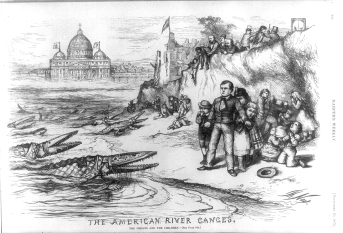
But if we are to fully understand Nast’s anti-Catholic drawings, his religious roots should not be overlooked, for this was the faith of his parents.
In nineteenth century America there were many reasons for Catholics to convert. Love may certainly have been one of the reasons. In my own family history, the reverse seems to have been true. My paternal great grandparents, Bavarian Lutherans, were very upset that their daughter (my grandmother) fell in love with, and at the turn of the twentieth century, decided to marry an Irish Catholic and convert to Catholicism.
Without precisely knowing when Nast converted, likely, there was more to it than just amoré. Nast emigrated to New York City in 1846, about the same time the potato crop was failing in Ireland. The Irish had been coming to America long before then – but most Irish emigrants in the seventeenth and eighteenth centuries (about 70 percent) were Presbyterian (Scots or Ulster Irish) and 30 percent percentage were were other Protestants, such as Anglicans or Dissenters (Baptists or Quakers, William Penn being the most famous of the latter). Kerby Miller’s research indicates Roman Catholics comprised a small minority of Irish emigres, and there were social, cultural and economic pressures for pre-Revolutionary Catholic emigrants to convert to Protestantism, typically to the very similar Episcopalian faith. As the American colonies were still very much under the influence of England, Catholics were afforded few property rights, an exception being Maryland and small parts of Pennsylvania.
After the Revolution and the enactment of The Bill of Rights, Catholics in American could relax. After the Napoleonic Wars, Irish immigration to America picked up. From 1815 to 1840, a second wave of Catholics left Ireland for better opportunities. These Catholics, generally speaking, saw the writing on the wall as their native Ireland fell sway to British oppression. Increases in tithes and taxes and decreases in land ownership rights, particularly for Catholics, fueled their immigration to America, and also to Canada and Australia. Emigration to the latter two countries was encouraged by the British government who often underwrote the travel expenses.
These pre-Famine Irish Catholics arrived in America with agrarian skills and a bit of money in their pockets, poor, but not destitute. This small distinction enabled them to move out of East Coast port cities toward opportunity in the American West (at that time east of the Mississippi), and to the South. They did not congregate in large cities as the Famine immigrants were forced to do. Whether they converted or not, Miller suggests this second wave of Irish immigrants, were for the most part, accepted into American mainstream, in part because population numbers did not make them conspicuous. They did not stand out or appear to have congregated in large enough numbers to be alarming to the Protestant status quo which still dominated in the expansive American West.
This perception changed with the Great Famine and its aftermath. While historians like Kirby Miller estimate about a million Irish of mixed faith came over from 1815 to 1845, they did so over a 30-year span and spread out all over the country. During the Famine years of 1845-1855, one and a half million destitute and desperate Irish emigrated to the Northeast region of the U.S., usually New York City, and there they conspicuously remained. Almost entirely Roman Catholic, the third wave of new arrivals had no money, nowhere to go, and few relatives to claim them. The first impressions these Irish Catholics left upon the New York and Protestant status quo was anything but positive.
They came to be known as the “shanty Irish” who are depicted in Gangs of New York (book and film) Sante’s Low Life and also Tyler Anbidner’s excellent, factual account of Five Points neighborhood, the most notorious of the the quickly built, inadequate tenements of the Fourth and Sixth Wards. Most Irish had little choice but to call the city tenaments home. They lived in slums under the most horrible of conditions with few skills or opportunities to improve their lot. As a result, many were forced to adopt vice and crime as a means of survival. If the Irish Catholics did find honest work, it was the most demeaning and menial of work as domestic help or as low paying textile workers and shirt makers. From a Protestant perspective, the Irish arrivals practice of a strange, cultist form of Christianity, and their inexplicable worship a foreign man on a Roman throne, further solidified the notion that the Irish stuck together like glue and didn’t want to assimilate or become “American.”
Consequently, the terms “Irish” and “Catholic” became synonymous —absolutely interchangeable and derogatory in usage.
As a result, Protestant Irish no longer self-identified as Irish, preferring to make the distinction as “Scots/Scotch Irish” or” Ulster Irish” and some affiliating as “Orangemen” in honor of William III of Orange who subdued Catholic James II at the Battle of the Boyne, or better yet, just plain American. They did not want their Protestant Irish ancestry associated with the slum Irish. The Germans immigrants who arrived before and around the same time as the Famine Irish, emigrated mostly for political reasons and left their homelands with money as well as useful skills — artisans with a trade which advanced their livelihood and living conditions in America. Although many nationalities and races were present at Five Points, the majority of skilled Germans lived in neighborhoods on the west side, in areas that are today known as Greenwich Village and Tribeca.
Nast’s biographer, Albert Bigelow Paine (also Mark Twain’s biographer) makes a point to place the Nast family in a “respectable” house on Greenwich Street. Paine does not mention the Nast family faith at all, but early on provides a hint of where Nast’s Catholic problem may have had originated:
His [Nast] early religious impressions were confusing. There were both Protestants and Catholics in Landau, and once at a Catholic church he saw two little girls hustled out rather roughly for repeating some Protestant prayers. This incident disturbed him deeply. He resented the treatment of these little girls. It may have marked the beginning of a bitterness which long after was to mature in those relentless attacks upon bigotry which won for him the detestation, if not the fear, of Pope and priest (6).
In New York City, Nast was educated in the Catholic faith, at least until the age of seven. Never a promising student, his parents moved him to different schools to see if an academic spark would ignite. Paine continues,
A little later, by advice of his father he attended a German school though only for a brief period. He left when required to confess, regarding his sins as too many and too dark for the confidences of the priest’s box. A brief period at another German school followed, and a term at a Forty seventh Street academy, considered then very far uptown. It was all to no avail. (14-15).
The mid-nineteenth century (1840-1860) saw a fervent rise in nativist sentiment and anti-Catholic rhetoric. The Know-Nothings rose and gained political power by essentially feeding into a growing anti-foreign, anti-Catholic paranoia.
“Catholic traditions continued to look dangerously un-American partly because they did not harmonize easily with the concept of individual freedom embedded in the national culture” (Higham 6).
They also drew very strong political lines — and politics would play a huge part in defining the anti-Catholic sentiment. Aside from their strange faith and odd practices and preoccupation with politics in their native Ireland, Catholics were successfully recruited by and subsequently aligned with the Democratic Party, which among other things, was staunchly anti-abolitionist. The Catholic Church took the unpopular position of not wanting to rock boat in their new home, on the issue of slavery. The Catholic Church was very keen to earn headway and inflfuence in the U.S. They believed in the law of the land and that law included slavery. The official position of the church was to let slavery continue.
Republicans, the Know Nothing factions among them, found the Catholic position on slavery reprehensible. During the Civil War, the Democratic Party affiliated and aligned with the Confederate South, and despite exceptions and Union loyalists, the majority of Irish and Catholics sympathized with Confederate side.
These pressures may have propelled a young Thomas Nast, and others like him, to convert. It may have been in pursuit of love (his intended was Espicopalian), the taint of Irish Catholicism, or from a desire to ascend and better assimilate in New York society. Given Nast’s staunch abolitionist views, it is not unreasonable to assume the American Catholic Church’s position on slavery had a lot to do with his conversion and continued skepticism of Irish Catholics in New York.
Nast did not hide his Catholic roots however. At the height of his fame during the Tweed era, Harper’s Weekly introduced their star artist to readers with a brief biography and engraved photo. Nast was described as Catholic, a fact that Harper’s clearly felt bolstered Nast’s integrity and the real purpose of his attacks on the American Catholic Church’s relationship with Tweed and New York City finances. It was the issue at hand, and not the people or faith that Nast attacked.
The pro-slavery position of Northeast Catholics during this time is not something that is well known among today’s Catholics. Modern Catholics might find the revelation of their history on this issue in America shocking. Certainly, it is not a part of a history that American Catholics choose to highlight and brag about. Nonetheless it is an ugly part of the American Catholic past that did factor into perceptions of the time. The Democratic Party was on the wrong side of a pressing moral issue. Irish Catholics strengthened the Democratic Party and therefore had a indirect role in blocking the progress for civil rights. Abolition attitudes ran very strong in Republican and Protestant circles, and may have contributed to social and moral pressures for Nast to abandon his ancestral family faith, and view American Catholics – Irish Democrats with increased scrutiny.
Nast’s images about Catholicism are brutal, but they erupt from specific issues (public school funding) and the social policies of dominant political figures (Tweed). The Irish’s persecution of Chinese Americans likely factored into Nast’s attention and sarcastic scrutiny.
Thomas Nast (1840-1902) was an amazingly talented and controversial artist during the latter half of the nineteenth century. Illustrator, painter, engraver, he is best known for his scathing caricatures and political cartoons that appeared in Harper’s Weekly’s Journal of Civilization, and which called out corruption and hypocrisy in American and especially New York City politics.They often referred to Nast as “Our Special Artist.”

Nast remains controversial today. His most recent nomination for induction into New Jersey’s Hall of Fame (Nast lived the majority of his time in Morristown) was doomed after a flurry of outrage and has been tabled for another year. With our politically correct fixations, he may never get in.
I first learned about Nast when I began exploring my family’s genealogy on sites like Ancestry.com. My lineage is 75 percent potato famine Irish, 25 percent Bavarian German. Raised in the Roman Catholic faith, if asked, my family identified ourselves as Irish-Catholic, but it was never a zealous, over-the-top kind of thing. I grew up thinking we were just “American” like everyone else. A sense of ancestral family history was never conveyed in our home. I was unaware of the experiences of my immigrant ancestors.
After seeing the 2002 film Gangs of New York, directed by Martin Scorsese, and watching an interview about the making of the film on Charlie Rose, I learned about a book titled Low Life: Lures and Snares of Old New York by Luc Sante (1992) and I decided to get a copy. It was a fascinating account of the American immigrant experience during the Gilded Age of New York City. It was through this reading that I first learned about Thomas Nast. I was surprised to discover that the Irish were looked upon as low life and wrote about it in an early blog.
For my first graduate course, American Art and Culture in Context, each student was assigned to select an artist to represent each century of American history and determine the cultural context in which it was created and why it was significant. I decided to narrow my focus to a particular genre, political/editorial cartoons, and selected Benjamin Franklin as an artist for the eighteenth, Thomas Nast for the nineteenth, and Patrick Oliphant for the twentieth century. Cartooning has always held a fascination for me. As a teenager, I was an amateur pen and ink artist. I fancied myself as a cartoonist and envisioned my career landing in newsprint. I had every intention of selecting art as my major in college and formally honing my skills and artistic voice – but when I found out that all the art classes began at 8 a.m. in the morning, I decided to switch my major to English. True story. Such is the wisdom of a 17-year old that puts sleeping in late at the top of her priorities!
Nevertheless, for me, an appreciation for art, and a particular enthusiasm for the oeuvre of Thomas Nast endures. It coincides well with my curiosity about nineteenth century American history, family heritage, politics in general, and how art influences culture and vice versa.
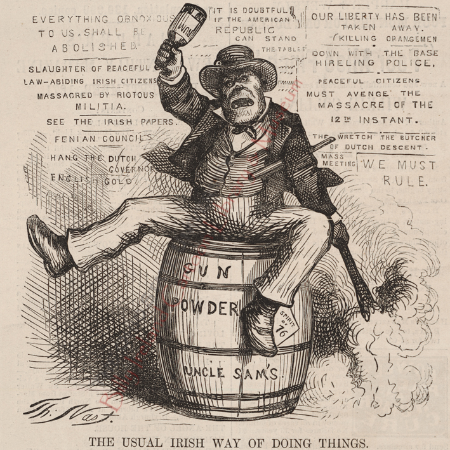
Thomas Nast is misunderstood. Given my heritage, I claim every right to put Nast on a $hit list, but I have chosen not to do so. I am not pleased to see my ancestors depicted as apes. I want to know where this comes from and why the stereotype, which originated in Great Britain, migrated to the United States and continued to thrive here for generations. I want to understand what made him draw images like this. Nast did not invent this stereotype, but he certainly perpetuated it. The image at right, The Usual Irish Way of Doing Things has made many appearances on the Web as an example of his vile Irish defamation. It is not a flattering portrait. The image is usually cropped to remove the story below, nor is it considered in the context of events that caused Nast to create the image. To fully understand the image, we need to understand the back story (which I will elaborate on in a future post).
One of the benefits of being trained as a journalist (aided by my position as a middle child) is to make oneself aware of all points of view, and present facts in context. It’s easy to stand on a soap box or slip behind a screen and keyboard and rant and rave about policies and positions – an advocate who is right and who is wrong. It would have been very easy to emotionally react to these images and be offended by what at first glance appears as cruel, salacious and mean spirited drawings spewed from Nast’s pen, brush, and pencil. Those were “my people” he maligned. Few would blame me for jumping on the “outrage” bandwagon.
I did not react with anger or outrage. Instead, I’ve chosen to ask “why?” Was Thomas Nast a racist? A hater? And if so, how does that happen to someone? Bigotry doesn’t occur in a vacuum. It is learned. How did his time, place and circumstance shape his views? Why does he appear to turn against the faith he was born into and raised for a time? Perhaps my minority Bavarian DNA has something to do with an internal need to find balance and explanation. I wanted to get as many sides of the Thomas Nast story as I could. As these pages and blog posts unfold, I will share the images in historical context, supported by academic research and established differences of opinion, including my own. Fair assessments based on facts. Those afternoon courses in good old fashioned journalism did not go to waste! You are welcome to draw your own conclusions, and by all means, share them.
Therefore, it is the purpose of this site to define who Thomas Nast was, what his politics were, his general philosophies and determine what exactly was his beef with the Irish and the Catholics? How did he treat other minority or immigrant groups? Scholars and students of Thomas Nast will generally agree he was a product of his time, he adopted and practiced a new form of Republicanism that was hard won by Abraham Lincoln, which advocated toleration for all races and creeds. When Nast called out the Irish or the Catholics, he did so to protest specific behaviors or practices that he felt were an abuse of power or ran hypocritical of American democratic ideals.
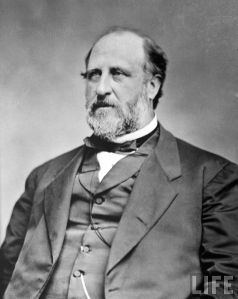
In Nast’s world, Irish and Catholics are inexorably intertwined with William Meager Tweed, the Tammany Hall Sachem or “Boss” that ran a corrupt “Ring” in New York City. Tweed was a Scots-Irish Presbyterian, and as a younger man was no admirer of Irish Catholics. All of that changed when Tweed quickly figured out the political value of this massive immigrant population. He cultivated the allegiance of the Irish and the Roman Catholic Church for expedient political reasons. In the view of many at the time, especially for the Republican, Protestant ruling elite, Tweed’s arrangement was a malodorous quid pro quo – votes for favors. That the Irish allowed themselves to be so manipulated by Tweed and how a particular church grew and benefited directly as a result of Tweed’s support with public funds is at the heart of Nast’s ink and ire.
Thomas Nast did not have a fundamental problem with the Irish or with Catholics. His family faith was Catholic! Nast was consistent in calling out corruption and hypocrisy wherever he saw it emerge. Had it not been for their political alliances, which in Nast’s view involved stolen elections and misappropriated public funds, there would be little reasons for Nast to attack the Irish Catholics. His pen would turn on anyone, or any group, who he felt had turned on his or her principles or moral code. I will examine Nast’s use of symbols and stereotypes and seek to explain, rather than excuse their employment in his work and commentary. Everything Nast drew, was executed with deep conviction. One may not agree with Nast’s conclusions, but those who are informed of his life and times find it difficult to question the well of integrity and consistency from with which Thomas Nast drew his creative inspiration.